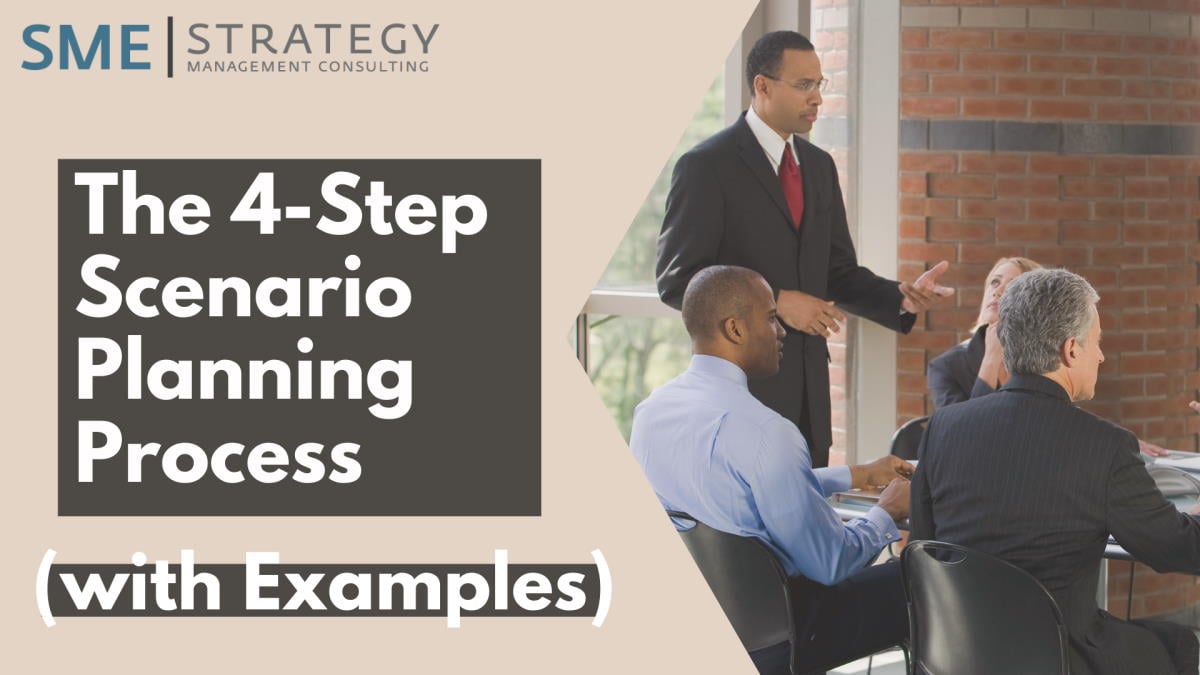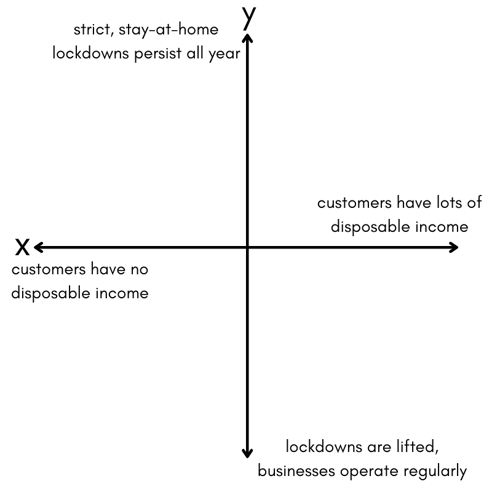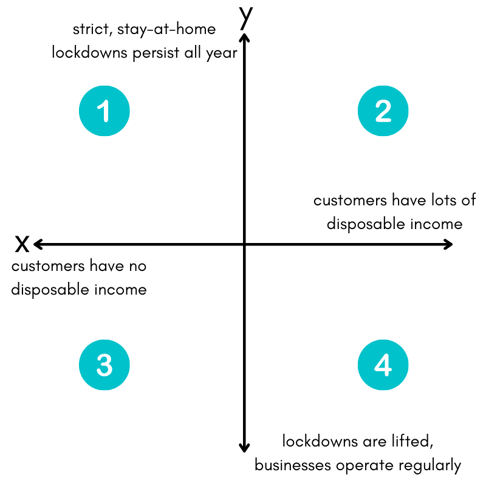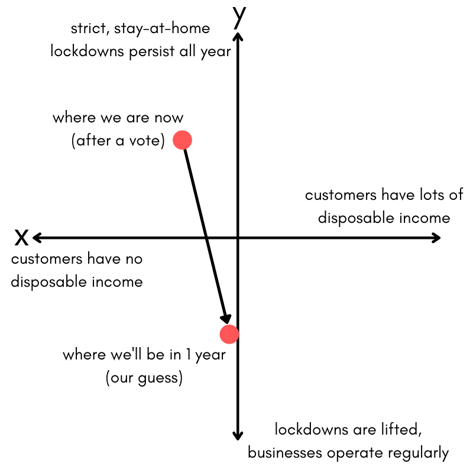
Updated May 2023
In business and in life, things can take a turn whether you're ready or not. And that's what happened. Lockdowns, travel bans and closures have forced people around the world to rethink their business, make sharp pivots , or flounder in the face of uncertainty.
While nobody can predict the future, we can look closely at a series of scenarios that could happen in the next 2, 5 or 10 years. The time frame you choose is up to you, but try to choose one that makes the most sense in your industry. If you're a small business, we recommend a 1, 2 or 3 year scenario plan during your offsite facilitation in order to remain agile (look at what happened in just one year).
By preparing ourselves for those scenarios before they happen, we're putting ourselves in a better position to react to what actually happens.
It's important to remember that stakeholder engagement plays a significant role in scenario planning. By engaging stakeholders in the scenario planning process, we can gather insights into how different scenarios may impact them and take those insights into account when developing our strategy.
The scenario planning process itself is a simple one, yet many people and businesses tend to overlook it. It requires dedicated time with your leadership team, along with the ability to take an honest look at your business and its environment.
Related Content:
What is Scenario Planning & How to Use It
How to Create Team Alignment and Why it's Critical in 2023
Here, we'll explain each of the 4 steps in the scenario planning process, along with some relevant examples:
Step 1: Identify Driving Forces
To kick off the scenario planning process, we'll identify the driving forces that could have an affect on your organization. To do that, we'll be using a PESTLE analysis. The purpose of this analysis is to extract as much as we can from the world around us that could impact your organization in any way. Now is the time to be thorough. For a video walkthrough: How to do a PESTLE Analysis.
Also, keep in mind that these don't necessarily have to be negative events. Although we tend to focus on what will impact us in the worst way, it's worth considering some of the more positive factors that could still make a big impact.
Let's get started:
Political: The political section of this analysis examines anything that your government or even another government could do to impact your organization. Government regulation varies throughout the world, but this should ultimately be one of the more straightforward sections of the analysis. Here are some examples:
- your income tax rate is increased by 5% (this could also be labelled an economic factor)
- mounting 'red tape' in the industry
- the federal government has a trade war with a country you rely on for manufacturing
- a new leader is elected
Economic: The economic factors include anything that affects you or your customers financially. These factors could be happening on a macro level if it means they trickle down to you, or they may be happening at a local level. Here are some examples:
- the price of raw materials you rely on skyrockets
- the unemployment level in your city rises
- your customers' disposable income increases
- the exchange rate between your country and another you rely on fluctuates dramatically
Social: The social section of this analysis is otherwise knows as 'Societal', and identifies any social, demographic or cultural issue or event that could impact your organization and its industry. Here are some good examples:
- the population in your target market is aging
- people are becoming more interested and engaged with health and wellness
- because of the pandemic, social pressure causes people to stay inside
- social media influencers are heavily influencing buying choices
Technological: The technological forces affecting business have been some of the strongest ones during this past year. These forces include anything related to technology and the internet that is having an influence on your organization. Here are some examples:
- thanks to video chatting tech, people are enabled to work from home full time
- automation in your industry is increasing at an alarming rate
- the increased threat of ransomware and cyberattacks
- global internet connectivity is making big progress
Legal: The legal factors of this analysis explore both external and internal laws, regulations, safety standards and policies that could affect the population or your organization. Here are some good examples:
- the government mandates strict business hours to slow the spread of COVID-19
- there is a COVID-19 outbreak at one of your facilities
- new employment laws require you to pay your employees more
- sanctions ban you from trading with a certain country
Environmental: The environmental factors identify anything that's happening to your surrounding environment, geography or climate. This could be happening on a global scale or just locally. Here are some examples:
- a major weather event occurs, which devastates part of your area
- heavy pollution in the air or water
- customers are springing for renewable, recyclable or efficient products
- the global average temperature increases
> Watch below: Scenario Planning for a Post-Pandemic Future w/Lance Mortlock from EY
Step 2: Identify Your Critical Uncertainties
Now that you've identified all of the driving factors that could impact your organization, it's time to pick out two that could have the greatest impact - these do not have to be similar. In fact, it’s beneficial if they’re very different.
Then, for each of these critical uncertainties, consider the extreme end of the spectrum for each one.
Although there are an unlimited number of possible scenarios, we recommend working through this exercise with one pair first.
Choosing just two can be tricky. If you've done step 1 thoroughly enough, you should have dozens of driving factors to choose from. Keep in mind you can always repeat the process to end up with a variety of scenarios.
To make it easier, consider both the factors that will cause the largest impact on your organization, and the factors that are the most likely to occur in the time frame you've agreed upon.
Let's try an example.
For this example, we'll look at a time frame of just one year. The critical uncertainties that we'll choose are:
- stay-at-home lockdowns
- disposable income of our customers
Interested in finding out if your team is aligned or not? Download this free scorecard to do with your team.

Step 3: Develop Plausible Scenarios
For the 3rd step, we will be developing plausible scenarios based off of the two critical uncertainties we've chosen. In this example, our critical uncertainties are: stay-at-home lockdowns and disposable income of our customers.
The way we'll develop these scenarios is by plotting them on a simple graph with an x-axis and y-axis.
We'll choose one of our critical uncertainties, and plot both extremes on either side of the x-axis. We'll then do the same for our other critical uncertainty on the y-axis. See the example below:

After you've plotted your uncertainties on the graph, it's time to describe each of the four scenarios (quadrants). As a team, you'll want to describe these scenarios in detail and in present tense, as if you've travelled through time. You've seen the future, and you'll be able to describe it in depth. Be sure to include what life is like at the office, at home, in your business environment and your industry.
In this case, any scenario in the top-left quadrant would be the least desirable.. our customers would have no disposable income, while strict lockdowns would persist.
In contrast, a scenario placed in the bottom-right quadrant would be ideal because customers would have lots of disposable income, while the lockdowns would be completely lifted.
You get the idea. In most cases, reality exists somewhere between, and not in the extremes.
Step 4: Discuss Implications of Paths
In the fourth and final step of the scenario planning process, you'll gather your team and discuss the implications of each scenario. Clearly, the impact of scenario 1 vs. scenario 4 will be very different (shown below), but it's important to cover each scenario - even if one seems unlikely. See the graph below:

Once you've discussed the implications of each scenario, take a vote from everyone in the room, asking where they think the organization is currently, asking 'Which quadrant are we in?' and 'How close to each axis are we?'.
When you've agreed upon where the organization is as a team, draw a line in the direction you think the your reality will move towards over your agreed upon time frame (we used one year in the example). Then, discuss what your organization can do to prepare for that reality. See the graph below for an example:
 This exercise will be extremely useful during the strategic planning process. When developing a strategic plan for your organization with your team, you'll want to factor in some of these scenarios. You may even want to do the scenario planning process several times with different critical uncertainties to be sure you're prepared for a range of scenarios.
This exercise will be extremely useful during the strategic planning process. When developing a strategic plan for your organization with your team, you'll want to factor in some of these scenarios. You may even want to do the scenario planning process several times with different critical uncertainties to be sure you're prepared for a range of scenarios.
In the strategic planning process, this scenario planning exercise should be taken into consideration when developing your vision, mission and goals. Even your action plan and operations could be affected.
To integrate scenario planning before, during, or after the strategic planning process, learn more about how our strategic planning services can help align your team around a clear strategic direction.
For a summary of the scenario planning process, check out this infographic below:

If the years 2020 and onwards have taught us anything, it's that the future is uncertain. If your organization is looking to plan around uncertainty, find out how working with a strategic planning facilitator can help you consider various risks and scenarios throughout the strategic planning process:



